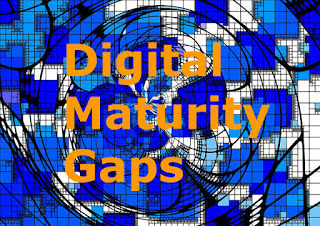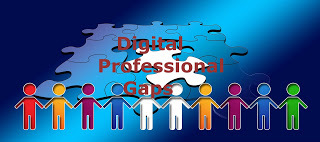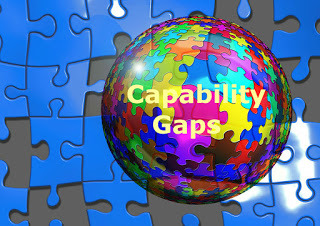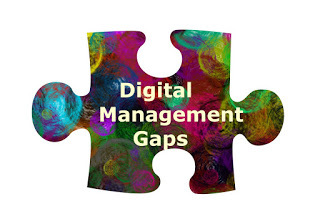Pearl Zhu's Blog, page 1240
March 29, 2017
The New Book “Digital Gap” Conclusion: Bridging Gaps to Catalyze Digital Maturity
 Digital is the new paradigm shift to deeply connect the business with the nature ecosystem. Digital make the business flatter and the world smaller because of hyper-connectivity and interdependence. On one side, the idea of digital lenses is to help people reach a shared understanding of “see the whole”; on the other side, digital indeed enlarges the thinking and capability gaps because different organizations, functions, and individuals evolve with varying speed. Hence, bridging the multitude of digital gaps is challenging, especially today, many organizations are still operated with the silo mentality and practice the traditional management discipline. Hence, this book “Digital Gaps” intend to throw some light, and guide both digital leaders and professionals to identify, analyze, as well as close the multiple digital gaps in a systematic way, and gain an in-depth understanding of the digital reality.
Digital is the new paradigm shift to deeply connect the business with the nature ecosystem. Digital make the business flatter and the world smaller because of hyper-connectivity and interdependence. On one side, the idea of digital lenses is to help people reach a shared understanding of “see the whole”; on the other side, digital indeed enlarges the thinking and capability gaps because different organizations, functions, and individuals evolve with varying speed. Hence, bridging the multitude of digital gaps is challenging, especially today, many organizations are still operated with the silo mentality and practice the traditional management discipline. Hence, this book “Digital Gaps” intend to throw some light, and guide both digital leaders and professionals to identify, analyze, as well as close the multiple digital gaps in a systematic way, and gain an in-depth understanding of the digital reality.
Bridging collaboration gaps to harness innovation: With emergent digital technologies and collaboration tools, for scaling collaboration, some companies have created institutional platforms that focus on building longer-term relationships, sustaining collaboration, allows participants to develop subject knowledge over time and focus more directly on business objectives and driving digital transformation. It also involves hiring the right talent, setting up the crucibles to allow for greater innovation within the teams that are close to product development/sales/marketing/distribution, Collaborating strategically across lines of business, understanding and speaking the common business language.
Bridging resource gaps for maintaining the digital balance: In order to adapt to the fast-paced changes, organizations today need to bridge resource gaps and streamline digital flows. In other words, try to digitally connect key resources/assets in their vicinity/context to the resource-rich innovation hub/clusters across the business ecosystem. In doing so, you can create the collegiality and shared context for learning, to keep information flow and digital balance.
 Bridging insight gaps to improve decision maturity: The digital era is volatile, complex, uncertain, and ambiguous, to get into the deep, deep digital reality, businesses today must bridge the insight gap to both frame problems and solve them effectively. In the static and command-control industrial era, when conformity to expectations is very highly encouraged, and independent thinkers are often seen as troublemakers. However, digital is the age of innovation, and inclusiveness must become the part of your business DNA, to avoid group thinking, bridge insight gaps improve decision maturity, and cultivate the culture of learning agility.
Bridging insight gaps to improve decision maturity: The digital era is volatile, complex, uncertain, and ambiguous, to get into the deep, deep digital reality, businesses today must bridge the insight gap to both frame problems and solve them effectively. In the static and command-control industrial era, when conformity to expectations is very highly encouraged, and independent thinkers are often seen as troublemakers. However, digital is the age of innovation, and inclusiveness must become the part of your business DNA, to avoid group thinking, bridge insight gaps improve decision maturity, and cultivate the culture of learning agility.
Bridging multiple digital gaps is one of the significant steps in digital strategy management, create the synergy of orchestrating digital symphony, enforcing deep understanding of the necessity of systems awareness, accelerate digital flow, discover the alternatives to problem-solving, and make a leap of business transformation.
Follow us at: @Pearl_Zhu
Published on March 29, 2017 23:28
CIOs as Chief Insight Officer: How to Run IT from a Controller to a Digital Catalyzer
There is no one size fits all digital formula for the digital shift, every IT organization has to set its own pace, explore its own sets of best practices and next practices, to build business competency and elevate digital maturity.
 Due to the accelerating speed of changes and exponential growth of information, IT running in an industrial mode as a business controller or a restraint only no longer fits in the dynamic business circumstances or volatile digital new normal. Forward-looking companies are empowering their IT organization to lead changes and drive digital transformation. But more specifically, how to run IT with the growth mentality and digital speed? How to improve IT organization's maturity from a support function to a digital catalyzer?
Due to the accelerating speed of changes and exponential growth of information, IT running in an industrial mode as a business controller or a restraint only no longer fits in the dynamic business circumstances or volatile digital new normal. Forward-looking companies are empowering their IT organization to lead changes and drive digital transformation. But more specifically, how to run IT with the growth mentality and digital speed? How to improve IT organization's maturity from a support function to a digital catalyzer?
IT as the business growth catalyzer: Thanks for the latest lightweight digital technologies, IT organizations are shifting from the monolithic industrial mode to mosaic digital style. Running IT as a business catalyzer means that IT does no longer live in a silo as a commodity no one care about if the “lights are on.” Rather, there are very few businesses today can state that IT does not play a significant role in the long-term strategic positioning of the company, and all forward-thinking organizations claim they are in information management business. Nowadays, IT is a significant part of the business strategy, and not simply as a tool or mechanism to support business goals, but a business enabler and digital engine. Digital IT catalyzes information flow and drives business changes proactively. To catalyze business, IT has to recharge itself as well, to engage IT employees and digitalize its own processes. At the age of IT consumerization, businesses need to understand not only the power and the opportunity information could bring in, but also the potential risks they might get exposed to. A good relationship between business and IT becomes visible by clearly defining tasks, authorities, and responsibilities to manage both opportunities and risks accordingly. IT involves co-creating business strategy. IT is switching from inside-out operation-driven to outside-in customer focus. This will allow IT to shine in both roles –as enabler and driver. IT proactively works as an integral part of the business to capitalize on opportunity via leading the transformation, or IT delivers the best solution to the business problems which meet business’s requirement or tailor customer’s needs. When maintaining a clear and efficient bottom line, with enough forward thinking to 'plan in' growth, and this dimension allows the IT organization to manage information and apply digital technologies to pour more on the top line.
IT as a business innovation catalyst: To transform IT from a controller to a catalyst, the digital mantra for forward-looking IT organizations is to "Do more with innovation." Innovation management is about transforming new ideas to achieve its business value. Hence, CIOs need to have business insight, not just through IT lenses, but via global business lenses. Then, they can practice that knowledge to start innovating at the organizational level and across business ecosystem. Digital catalyzes the culture of innovation due to the convenience of learning and sharing. How these ideas are recognized, filtered and dealt with well become a crucial factor in an organization's success in producing digitized products and services. IT can reframe business processes to keep ideas flow and implemented in continuous mode. Innovation follows basic rules which are adapted depending on the one company’s situation and ambition. IT can drive all sorts of innovation, proactively pushing ideas on how to leverage technologies to drive business growth, increasing business productivity, digitizing talent management, building business competency and improving customer satisfaction. To run IT as a business innovation catalyzer, IT leaders need to encourage their teams to spend more time with leaders on the business side as well as directly with customers, because a high-effective and high-innovative digital IT is about top-line business growth by maximizing ROI to add up overall business value in the second dimension.
 IT as the change catalyzer and digital accelerator: Digital is also about increasing the speed of change, hyperconnectivity, and fierce competition. A digital IT can both adapt to change and create necessary change effortlessly. Running a digital IT means to synchronize with business speed via integration and optimization, not just alignment and consolidation. Because enterprises have always been parts of simple and complex digital ecosystems, so to function seamlessly, an enterprise has to be linked to the many and varying touch points between itself and its dynamic environment. What should be focused on is the integration of IT into the business decisions and processes to be highly responsive. IT should proactively facilitate the business partners to the right solutions and help to implement them with speed. Nowadays speed matters for businesses’ surviving and thriving; speed matters for businesses to adapt to changes; to grasp the opportunities for marketing expansion; speed matters for building the new capabilities, gaining competency for the business’s continuous improvement.
IT as the change catalyzer and digital accelerator: Digital is also about increasing the speed of change, hyperconnectivity, and fierce competition. A digital IT can both adapt to change and create necessary change effortlessly. Running a digital IT means to synchronize with business speed via integration and optimization, not just alignment and consolidation. Because enterprises have always been parts of simple and complex digital ecosystems, so to function seamlessly, an enterprise has to be linked to the many and varying touch points between itself and its dynamic environment. What should be focused on is the integration of IT into the business decisions and processes to be highly responsive. IT should proactively facilitate the business partners to the right solutions and help to implement them with speed. Nowadays speed matters for businesses’ surviving and thriving; speed matters for businesses to adapt to changes; to grasp the opportunities for marketing expansion; speed matters for building the new capabilities, gaining competency for the business’s continuous improvement.
Digital transformation represents a break with the past, with a high level of impact and complexity. Therefore, running IT as a digital catalyzer is easy to say, and hard to achieve. It takes very solid leadership, focus, and the ability to build strong relationships with all levels of the organization. CIOs have to know both the business and the technology side of things. You cannot know only one piece of the equation. It means that the CIO’s niche leadership is based on the strategic mindset, multifaceted knowledge, and business understanding, as well as anticipated leadership styles. There is no one size fits all digital formula for the digital shift, every IT organization has to set its own pace, explore its own sets of best practices and next practices, to build business competency and elevate digital maturity.
Follow us at: @Pearl_Zhu
 Due to the accelerating speed of changes and exponential growth of information, IT running in an industrial mode as a business controller or a restraint only no longer fits in the dynamic business circumstances or volatile digital new normal. Forward-looking companies are empowering their IT organization to lead changes and drive digital transformation. But more specifically, how to run IT with the growth mentality and digital speed? How to improve IT organization's maturity from a support function to a digital catalyzer?
Due to the accelerating speed of changes and exponential growth of information, IT running in an industrial mode as a business controller or a restraint only no longer fits in the dynamic business circumstances or volatile digital new normal. Forward-looking companies are empowering their IT organization to lead changes and drive digital transformation. But more specifically, how to run IT with the growth mentality and digital speed? How to improve IT organization's maturity from a support function to a digital catalyzer?
IT as the business growth catalyzer: Thanks for the latest lightweight digital technologies, IT organizations are shifting from the monolithic industrial mode to mosaic digital style. Running IT as a business catalyzer means that IT does no longer live in a silo as a commodity no one care about if the “lights are on.” Rather, there are very few businesses today can state that IT does not play a significant role in the long-term strategic positioning of the company, and all forward-thinking organizations claim they are in information management business. Nowadays, IT is a significant part of the business strategy, and not simply as a tool or mechanism to support business goals, but a business enabler and digital engine. Digital IT catalyzes information flow and drives business changes proactively. To catalyze business, IT has to recharge itself as well, to engage IT employees and digitalize its own processes. At the age of IT consumerization, businesses need to understand not only the power and the opportunity information could bring in, but also the potential risks they might get exposed to. A good relationship between business and IT becomes visible by clearly defining tasks, authorities, and responsibilities to manage both opportunities and risks accordingly. IT involves co-creating business strategy. IT is switching from inside-out operation-driven to outside-in customer focus. This will allow IT to shine in both roles –as enabler and driver. IT proactively works as an integral part of the business to capitalize on opportunity via leading the transformation, or IT delivers the best solution to the business problems which meet business’s requirement or tailor customer’s needs. When maintaining a clear and efficient bottom line, with enough forward thinking to 'plan in' growth, and this dimension allows the IT organization to manage information and apply digital technologies to pour more on the top line.
IT as a business innovation catalyst: To transform IT from a controller to a catalyst, the digital mantra for forward-looking IT organizations is to "Do more with innovation." Innovation management is about transforming new ideas to achieve its business value. Hence, CIOs need to have business insight, not just through IT lenses, but via global business lenses. Then, they can practice that knowledge to start innovating at the organizational level and across business ecosystem. Digital catalyzes the culture of innovation due to the convenience of learning and sharing. How these ideas are recognized, filtered and dealt with well become a crucial factor in an organization's success in producing digitized products and services. IT can reframe business processes to keep ideas flow and implemented in continuous mode. Innovation follows basic rules which are adapted depending on the one company’s situation and ambition. IT can drive all sorts of innovation, proactively pushing ideas on how to leverage technologies to drive business growth, increasing business productivity, digitizing talent management, building business competency and improving customer satisfaction. To run IT as a business innovation catalyzer, IT leaders need to encourage their teams to spend more time with leaders on the business side as well as directly with customers, because a high-effective and high-innovative digital IT is about top-line business growth by maximizing ROI to add up overall business value in the second dimension.
 IT as the change catalyzer and digital accelerator: Digital is also about increasing the speed of change, hyperconnectivity, and fierce competition. A digital IT can both adapt to change and create necessary change effortlessly. Running a digital IT means to synchronize with business speed via integration and optimization, not just alignment and consolidation. Because enterprises have always been parts of simple and complex digital ecosystems, so to function seamlessly, an enterprise has to be linked to the many and varying touch points between itself and its dynamic environment. What should be focused on is the integration of IT into the business decisions and processes to be highly responsive. IT should proactively facilitate the business partners to the right solutions and help to implement them with speed. Nowadays speed matters for businesses’ surviving and thriving; speed matters for businesses to adapt to changes; to grasp the opportunities for marketing expansion; speed matters for building the new capabilities, gaining competency for the business’s continuous improvement.
IT as the change catalyzer and digital accelerator: Digital is also about increasing the speed of change, hyperconnectivity, and fierce competition. A digital IT can both adapt to change and create necessary change effortlessly. Running a digital IT means to synchronize with business speed via integration and optimization, not just alignment and consolidation. Because enterprises have always been parts of simple and complex digital ecosystems, so to function seamlessly, an enterprise has to be linked to the many and varying touch points between itself and its dynamic environment. What should be focused on is the integration of IT into the business decisions and processes to be highly responsive. IT should proactively facilitate the business partners to the right solutions and help to implement them with speed. Nowadays speed matters for businesses’ surviving and thriving; speed matters for businesses to adapt to changes; to grasp the opportunities for marketing expansion; speed matters for building the new capabilities, gaining competency for the business’s continuous improvement.
Digital transformation represents a break with the past, with a high level of impact and complexity. Therefore, running IT as a digital catalyzer is easy to say, and hard to achieve. It takes very solid leadership, focus, and the ability to build strong relationships with all levels of the organization. CIOs have to know both the business and the technology side of things. You cannot know only one piece of the equation. It means that the CIO’s niche leadership is based on the strategic mindset, multifaceted knowledge, and business understanding, as well as anticipated leadership styles. There is no one size fits all digital formula for the digital shift, every IT organization has to set its own pace, explore its own sets of best practices and next practices, to build business competency and elevate digital maturity.
Follow us at: @Pearl_Zhu
Published on March 29, 2017 23:24
CIOs as Chief Insight Officer: How to Run IT from a Controller to a Digital Catalyzer
 Due to the accelerating speed of changes and exponential growth of information, IT running in an industrial mode as a business controller or a restraint only no longer fits in the dynamic business circumstances or volatile digital new normal. Forward-looking companies are also empowering their IT organization to lead changes and drive digital transformation. But more specifically, how to run IT with the growth mentality and digital speed? How to improve IT organization's maturity from a support function to the digital catalyzer?
Due to the accelerating speed of changes and exponential growth of information, IT running in an industrial mode as a business controller or a restraint only no longer fits in the dynamic business circumstances or volatile digital new normal. Forward-looking companies are also empowering their IT organization to lead changes and drive digital transformation. But more specifically, how to run IT with the growth mentality and digital speed? How to improve IT organization's maturity from a support function to the digital catalyzer?
IT as the business growth catalyzer: Thanks for the latest lightweight digital technologies, IT organization is shifting from a monolithic industrial mode to mosaic digital style. Running IT as a business catalyzer means that IT is no longer live in a silo as a commodity no one care about if the “lights are on.” Rather, there are very few businesses today can state that IT does not play a significant role in the long-term strategic positioning of the company, and all forward-thinking organizations claim they are in information management business. Nowadays, IT is a significant part of the business strategy, and not simply as a tool or mechanism to support business goals, but a business enabler and digital engine. Digital IT catalyzes information flow and drives business changes proactively. To catalyze business, IT has to recharge itself as well, to engage IT employees and digitalize its own processes. At the age of IT consumerization, businesses need to understand not only the power and the opportunity information could bring in, but also the potential risks they might get exposed to. A good relationship between business and IT becomes visible by clearly defining tasks, authorities, and responsibilities to manage both opportunities and risks accordingly. IT involves co-creating business strategy. IT is switching from inside-out operation-driven to outside-in customer focus. This will allow IT to shine in both roles –as enabler and driver. IT proactively works as an integral part of the business to capitalize on opportunity via leading the transformation, or IT delivers the best solution to the business problems which meet business’s requirement or tailor customer’s needs. When maintaining a clear and efficient bottom line, with enough forward thinking to 'plan in' growth, and this dimension allows the IT organization to manage information and apply technology to pour more on the top line.
IT as a business innovation catalyst: To transform IT from a controller to a catalyst, the digital mantra for forward-looking IT organization is to do more with innovation. Innovation management is about transforming new ideas to achieve its business value. Hence, CIOs need to have business insight, not just through IT lenses, but via global business lenses. Then, they can practice that knowledge to start innovating at the organizational level and across business ecosystem. Digital catalyzes the culture of innovation due to the convenience of learning and sharing. How these ideas are recognized, filtered and dealt with well become a crucial factor in an organization's success in producing digitized products and services. IT can reframe business processes to keep ideas flow and implemented in continuous mode. Innovation follows basic rules which are adapted depending on the one company’s situation and ambition. IT can drive all sorts of innovation, proactively pushing ideas on how to leverage technologies to drive business growth, increasing business productivity, digitizing talent management, building business competency and improving customer satisfaction. To run IT as a business innovation catalyzer, IT leaders need to encourage their teams to spend more time with leaders on the business side as well as directly with customers, because a high-effective and high-innovative digital IT is about top-line business growth by maximizing ROI to add up overall business value in the second dimension.
 IT as the change catalyzer and digital accelerator: Digital is also about increasing the speed of change, hyperconnectivity, and fierce competition. A digital IT can both adapt to change and create necessary change effortlessly. Running a digital IT means to synchronize with business speed via integration and optimization, not just alignment and consolidation. Because enterprises have always been parts of simple and complex digital ecosystems, so to function seamlessly, an enterprise has to be linked to the many and varying touch points between itself and its dynamic environment. What should be focused on is the integration of IT into the business decisions and processes to be highly responsive. IT should proactively facilitate the business partners to the right solutions and help to implement them with speed. Nowadays seed matters for businesses’ surviving and thriving; speed matters for businesses to adapt to changes; to grasp the opportunities for marketing expansion; speed matters for building the new capabilities, gaining competency for the business’s continuous improvement.
IT as the change catalyzer and digital accelerator: Digital is also about increasing the speed of change, hyperconnectivity, and fierce competition. A digital IT can both adapt to change and create necessary change effortlessly. Running a digital IT means to synchronize with business speed via integration and optimization, not just alignment and consolidation. Because enterprises have always been parts of simple and complex digital ecosystems, so to function seamlessly, an enterprise has to be linked to the many and varying touch points between itself and its dynamic environment. What should be focused on is the integration of IT into the business decisions and processes to be highly responsive. IT should proactively facilitate the business partners to the right solutions and help to implement them with speed. Nowadays seed matters for businesses’ surviving and thriving; speed matters for businesses to adapt to changes; to grasp the opportunities for marketing expansion; speed matters for building the new capabilities, gaining competency for the business’s continuous improvement.
Digital transformation represents a break with the past, with a high level of impact and complexity. Therefore, running IT as a digital catalyzer is easy to say, and hard to achieve. It takes very solid leadership, focus, and the ability to build strong relationships with all levels of the organization. CIOs have to know both the business and the technology side of things. You cannot know only one piece of the equation. It means that the CIO’s niche leadership is based on the strategic mindset, multifaceted knowledge, and business understanding, as well as anticipated leadership styles. There is no one size fits all digital formula, every IT organization has to set its own pace, explore its own sets of best practices and next practices, to build business competency and elevate digital maturity.
Follow us at: @Pearl_Zhu
Published on March 29, 2017 23:24
March 28, 2017
The Monthly Digital Principles, Practices, and Performance Tuning Mar. 2017
Digital principles define why one make a decision one way or another.
 Principles are statements of values. Things that define why one make a decision one way or another. These core decision values guide the behavior of individuals within an organization. Digital does flatten the organizational hierarchy and blur the functional, organizational, and geographical borders in the business ecosystem, it could mean less restrict rules or bureaucracy, but it also means the guiding principles become more crucial to be defined as core decision values and behavior guidelines. It is less about controls, but more about the clarity of "why we make decisions the way we do” and what’re the expectations of employees' work performance?
Principles are statements of values. Things that define why one make a decision one way or another. These core decision values guide the behavior of individuals within an organization. Digital does flatten the organizational hierarchy and blur the functional, organizational, and geographical borders in the business ecosystem, it could mean less restrict rules or bureaucracy, but it also means the guiding principles become more crucial to be defined as core decision values and behavior guidelines. It is less about controls, but more about the clarity of "why we make decisions the way we do” and what’re the expectations of employees' work performance?
Three Core Principles in Accelerating Digital Innovation? Innovation is the specific phenomenon of the knowledge-based economy. It is about having new knowledge and new processes. It is also about too much knowledge in terms of too many good creative ideas and too little available resources. Innovation is about prioritization as well - via a systematic discipline that can "smell" the right idea at the right time and place, make it tangible, and achieve its business values.Setting the Right Principles for Change ManagementChange is inevitable, and organizational change becomes a common practice within an organization, but more than two-thirds of change effort fail to achieve the expected results. What’re the barriers to cause the change failures, and how to make Change Management tangible rather than fluffy, and manage change lifecycle effectively?Five Principles to Run a Digital IT? DDigital does flatten the organizational hierarchy and blur the functional, organizational, and geographical borders in the business ecosystem, it could mean less restrict rules or bureaucracy, but it also means the guiding principles become more crucial to be defined as core decision values and behavior guidelines. It is less about controls, but more about the clarity of "why we make decisions the way we do” and what’re the expectations of employees' work performance. From IT management perspectives, guiding principles let the organization know what to expect when dealing with IT, and serve as a yardstick by which to measure IT internally and externally, and can spur some great discussions with fellow C-suite members and business unit management. Here are five principles to run a digital IT organization. Three Principles to Encourage Professional Digital Competition? Competition is part of nature and human society. In nature, competition is for evolution, in business, competition is for surviving and thriving. Competition is part of the natural dynamics of life. It is part of the genetic bias of every living thing in nature as a survival-seeking mindset. There are ample examples of competitive behaviors in the animal world. In the primitive tropical forest, the competition is bloody and cruel for surviving only. In the silo industrial age, the competition is about commanding & controlling to get the certain order from chaos and keep the status quo; and now we are stepping into a far more advanced digital era steadily, the goal of the healthy competition in the human society is to encourage innovation and accelerate the speed of progression. How to set principles to encourage professional competitions and inspire innovation?? Three Principles for Communication Effectiveness Communication is always important, although it is the means to the end, not the end itself. The end is for problem solving and idea brainstorming. A great communicator doesn’t need to be “the everyone’s cup of tea,” but in order to communicate effectively and avoid the miscommunication symptoms such as “lost in translation,” you have to follow the right set of principles and deliver the messages persuasively and creatively.?The “Future of CIO” Blog has reached 1.8 million page views with about #3600th blog posting in 59+ different categories of leadership, management, strategy, digitalization, change/talent, etc. The content richness is not for its own sake, but to convey the vision and share the wisdom. Blogging is not about writing, but about thinking and innovating the new ideas; it’s not just about WHAT to say, but about WHY to say, and HOW to say it. It reflects the color and shade of your thought patterns, and it indicates the peaks and curves of your thinking waves. Unlike pure entertainment, quality and professional content takes time for digesting, contemplation and engaging, and therefore, it takes the time to attract the "hungry minds" and the "deep souls." It’s the journey to amplify diverse voices and deepen digital footprints, and it's the way to harness your innovative spirit.
Three Principles for Communication Effectiveness Communication is always important, although it is the means to the end, not the end itself. The end is for problem solving and idea brainstorming. A great communicator doesn’t need to be “the everyone’s cup of tea,” but in order to communicate effectively and avoid the miscommunication symptoms such as “lost in translation,” you have to follow the right set of principles and deliver the messages persuasively and creatively.?The “Future of CIO” Blog has reached 1.8 million page views with about #3600th blog posting in 59+ different categories of leadership, management, strategy, digitalization, change/talent, etc. The content richness is not for its own sake, but to convey the vision and share the wisdom. Blogging is not about writing, but about thinking and innovating the new ideas; it’s not just about WHAT to say, but about WHY to say, and HOW to say it. It reflects the color and shade of your thought patterns, and it indicates the peaks and curves of your thinking waves. Unlike pure entertainment, quality and professional content takes time for digesting, contemplation and engaging, and therefore, it takes the time to attract the "hungry minds" and the "deep souls." It’s the journey to amplify diverse voices and deepen digital footprints, and it's the way to harness your innovative spirit.
Follow us at: @Pearl_Zhu
 Principles are statements of values. Things that define why one make a decision one way or another. These core decision values guide the behavior of individuals within an organization. Digital does flatten the organizational hierarchy and blur the functional, organizational, and geographical borders in the business ecosystem, it could mean less restrict rules or bureaucracy, but it also means the guiding principles become more crucial to be defined as core decision values and behavior guidelines. It is less about controls, but more about the clarity of "why we make decisions the way we do” and what’re the expectations of employees' work performance?
Principles are statements of values. Things that define why one make a decision one way or another. These core decision values guide the behavior of individuals within an organization. Digital does flatten the organizational hierarchy and blur the functional, organizational, and geographical borders in the business ecosystem, it could mean less restrict rules or bureaucracy, but it also means the guiding principles become more crucial to be defined as core decision values and behavior guidelines. It is less about controls, but more about the clarity of "why we make decisions the way we do” and what’re the expectations of employees' work performance?Three Core Principles in Accelerating Digital Innovation? Innovation is the specific phenomenon of the knowledge-based economy. It is about having new knowledge and new processes. It is also about too much knowledge in terms of too many good creative ideas and too little available resources. Innovation is about prioritization as well - via a systematic discipline that can "smell" the right idea at the right time and place, make it tangible, and achieve its business values.Setting the Right Principles for Change ManagementChange is inevitable, and organizational change becomes a common practice within an organization, but more than two-thirds of change effort fail to achieve the expected results. What’re the barriers to cause the change failures, and how to make Change Management tangible rather than fluffy, and manage change lifecycle effectively?Five Principles to Run a Digital IT? DDigital does flatten the organizational hierarchy and blur the functional, organizational, and geographical borders in the business ecosystem, it could mean less restrict rules or bureaucracy, but it also means the guiding principles become more crucial to be defined as core decision values and behavior guidelines. It is less about controls, but more about the clarity of "why we make decisions the way we do” and what’re the expectations of employees' work performance. From IT management perspectives, guiding principles let the organization know what to expect when dealing with IT, and serve as a yardstick by which to measure IT internally and externally, and can spur some great discussions with fellow C-suite members and business unit management. Here are five principles to run a digital IT organization. Three Principles to Encourage Professional Digital Competition? Competition is part of nature and human society. In nature, competition is for evolution, in business, competition is for surviving and thriving. Competition is part of the natural dynamics of life. It is part of the genetic bias of every living thing in nature as a survival-seeking mindset. There are ample examples of competitive behaviors in the animal world. In the primitive tropical forest, the competition is bloody and cruel for surviving only. In the silo industrial age, the competition is about commanding & controlling to get the certain order from chaos and keep the status quo; and now we are stepping into a far more advanced digital era steadily, the goal of the healthy competition in the human society is to encourage innovation and accelerate the speed of progression. How to set principles to encourage professional competitions and inspire innovation??
 Three Principles for Communication Effectiveness Communication is always important, although it is the means to the end, not the end itself. The end is for problem solving and idea brainstorming. A great communicator doesn’t need to be “the everyone’s cup of tea,” but in order to communicate effectively and avoid the miscommunication symptoms such as “lost in translation,” you have to follow the right set of principles and deliver the messages persuasively and creatively.?The “Future of CIO” Blog has reached 1.8 million page views with about #3600th blog posting in 59+ different categories of leadership, management, strategy, digitalization, change/talent, etc. The content richness is not for its own sake, but to convey the vision and share the wisdom. Blogging is not about writing, but about thinking and innovating the new ideas; it’s not just about WHAT to say, but about WHY to say, and HOW to say it. It reflects the color and shade of your thought patterns, and it indicates the peaks and curves of your thinking waves. Unlike pure entertainment, quality and professional content takes time for digesting, contemplation and engaging, and therefore, it takes the time to attract the "hungry minds" and the "deep souls." It’s the journey to amplify diverse voices and deepen digital footprints, and it's the way to harness your innovative spirit.
Three Principles for Communication Effectiveness Communication is always important, although it is the means to the end, not the end itself. The end is for problem solving and idea brainstorming. A great communicator doesn’t need to be “the everyone’s cup of tea,” but in order to communicate effectively and avoid the miscommunication symptoms such as “lost in translation,” you have to follow the right set of principles and deliver the messages persuasively and creatively.?The “Future of CIO” Blog has reached 1.8 million page views with about #3600th blog posting in 59+ different categories of leadership, management, strategy, digitalization, change/talent, etc. The content richness is not for its own sake, but to convey the vision and share the wisdom. Blogging is not about writing, but about thinking and innovating the new ideas; it’s not just about WHAT to say, but about WHY to say, and HOW to say it. It reflects the color and shade of your thought patterns, and it indicates the peaks and curves of your thinking waves. Unlike pure entertainment, quality and professional content takes time for digesting, contemplation and engaging, and therefore, it takes the time to attract the "hungry minds" and the "deep souls." It’s the journey to amplify diverse voices and deepen digital footprints, and it's the way to harness your innovative spirit.Follow us at: @Pearl_Zhu
Published on March 28, 2017 23:29
The New Book “Digital Gaps” Chapter 5 Introduction: Digital Professional Gaps
 Generally speaking, a professional is an individual with the expertise of some specific area, who earns his/her livings from that expertise. Being professional also means that the individual not only has the skill but also presents the high-quality professionalism such as positive mentality, fair judgment, and good behaviors. Being a digital professional inherently and inextricably links with high levels of professionalism. So, how to identify digital professional gaps, and improve the workforce quality, creativity, collaboration, productivity, and engagement?
Generally speaking, a professional is an individual with the expertise of some specific area, who earns his/her livings from that expertise. Being professional also means that the individual not only has the skill but also presents the high-quality professionalism such as positive mentality, fair judgment, and good behaviors. Being a digital professional inherently and inextricably links with high levels of professionalism. So, how to identify digital professional gaps, and improve the workforce quality, creativity, collaboration, productivity, and engagement?
Communication gaps: Communication is the key to improving business effectiveness, modern management efficiency, and workforce harmonization. Communication gaps are often caused by cognitive difference, ambiguous process, or management bottleneck. Miscommunication is also caused by perception gaps because people have the different knowledge base and cognitive understanding to articulate things. Even two people observe the exactly same thing or participate the same conversation, they could perceive the situation and convey the message differently. Communication gaps decrease productivity, stifle innovation, cause mistrust, and decelerate the business speed. “The lost in translation” could happen at any level of the organization; for example, if people at the bottom and middle level don’t get the opportunity to understand the business's strategic goals via effective communication, they would be easy to get lost and inundated with daily tasks which perhaps do not add enough value to benefit both the business and the employees’ well-beings, they feel exhausted, bored, and lack of achievement. It perhaps needs to first categorize what kind of communication bottlenecks existing and which communication gaps should be closed. There are hard communication barriers such as, out of date processes, procedures, practices, or soft ones such as culture, politics, or leadership style, etc. Communication effectiveness can be improved when the hard barriers are broken down and soft obstacles are overcome.
Accountability gaps: Digital organizations advocate autonomy, mastering, and innovation. Lack of accountability is often one of the biggest obstacles to getting things done, or cause change inertia in the organization. Because people don’t feel “safe,” or run away from accountability because they had a personal experience or they have observed others being treated poorly or unfairly when being held accountable for results. It is not uncommon to confuse accountability with blame. They are actually opposites. Shared accountability or collective accountability involves shared ownership, empathetic communication, the true measure of accountability is determined not by whether someone or a team makes a mistake or not, but on how quickly they can recover so that customers, teammates, and others aren’t negatively affected by the breakdown. Accountability can be harnessed via motivating your employees to achieve higher than expected result and build the culture of learning, trust, and professionalism. It is also important to design a performance management system that enforces accountability. If you ensure the individuals have the autonomy within their tasks or projects, you will be able to address performance on an equal partnership base.
 Professional maturity gap: Maturity is about being fully developed and fully grown, it is just the opposite of being immature. Professional maturity means that you are fully developed in some way to fulfilling a role or function. Often, people are the weakest link in running high-performance businesses. Maturity is the combination of capability and potentiality. It is the ability of an individual to gauge or measure the capability or potentiality of a candidate for responding to a particular query-action-behavior-delivery of any thought processes, based on the level of response received at to the receiver’s end. Maturity is also a phrase we are using today to describe a decent level of emotional intelligence at work, lack of emotional intelligence will make a person look immature. Maturity refers to having a sound understanding of basics and making a fair judgment. Maturity is the balance between courage and consideration. Lack of understanding and adaptation can enlarge maturity gap. Maturity is simply having the ability to live comfortably with contradictory thoughts, and expressing things sometimes courageously by taking care of the feelings of the other people as well. It is related to handling a situation wisely, taking responsibility, being accountable for both what you say and what do. So, professional maturity is about ripeness, thoughtfulness, quality, balance, and wisdom.
Professional maturity gap: Maturity is about being fully developed and fully grown, it is just the opposite of being immature. Professional maturity means that you are fully developed in some way to fulfilling a role or function. Often, people are the weakest link in running high-performance businesses. Maturity is the combination of capability and potentiality. It is the ability of an individual to gauge or measure the capability or potentiality of a candidate for responding to a particular query-action-behavior-delivery of any thought processes, based on the level of response received at to the receiver’s end. Maturity is also a phrase we are using today to describe a decent level of emotional intelligence at work, lack of emotional intelligence will make a person look immature. Maturity refers to having a sound understanding of basics and making a fair judgment. Maturity is the balance between courage and consideration. Lack of understanding and adaptation can enlarge maturity gap. Maturity is simply having the ability to live comfortably with contradictory thoughts, and expressing things sometimes courageously by taking care of the feelings of the other people as well. It is related to handling a situation wisely, taking responsibility, being accountable for both what you say and what do. So, professional maturity is about ripeness, thoughtfulness, quality, balance, and wisdom.
A professional is an individual who strives to represent skills and delivers quality. A digital professional presents high mature professionalism which means - the mastery of digital capabilities, the sound judgment via independent thinking and multidimensional thought processes, the positive attitude, and the humility to the things they don’t know, and the good behaviors to act cohesively.
Follow us at: @Pearl_Zhu
Published on March 28, 2017 23:23
Digital Transformation: From Deficiency & Inefficiency to Proficiency and profundity
 We are at the dawn of digital age with the exponential growth of information and tremendous changes. When led effectively, organizations can take the path to the next level of effectiveness and innovation; when led without a clear vision, it means information overloading, further confusion, and business ineffectiveness. As transformative digital leaders, can you participate proactively, look optimistically ann engage constructively toward needs to be able to recognize areas of deficiencies and inefficiencies, then ask the question “What if?” and 'How can we...?' And lead your organization to reach the level of proficiency and profundity?
We are at the dawn of digital age with the exponential growth of information and tremendous changes. When led effectively, organizations can take the path to the next level of effectiveness and innovation; when led without a clear vision, it means information overloading, further confusion, and business ineffectiveness. As transformative digital leaders, can you participate proactively, look optimistically ann engage constructively toward needs to be able to recognize areas of deficiencies and inefficiencies, then ask the question “What if?” and 'How can we...?' And lead your organization to reach the level of proficiency and profundity?
Knowledge proficiency: It is the paradigm shift from knowledge scarcity in the industrial age to knowledge abundance in the digital era. At today’s digital dynamic, information is abundant and even explosive. To quote Peter Drucker, knowledge is the most valuable commodity. It couldn’t be truer in the digital era. On one hand, the fresh knowledge can be captured from the abundance of information; on the other hand, it doesn’t take long for that knowledge to become a commodity once the market is exposed to it. Besides people, information is one of the most valuable assets in the organization today, thus, the idea of applying the asset management principles to arrange your own corporate knowledge strategy is worth exploring, although knowledge is more intangible, complex and dynamic compare to the physical asset, the organizations should be able to put some measurable value on the information and knowledge assets because it is "vital" to the business. Hence, information management and knowledge management should be managed holistically as the corporate asset; if done properly; it can turn the most valuable personally-owned information and knowledge assets into corporately owned assets. To reach the state of knowledge proficiency, it is also important to identify and close the gap between knowledge and insight, and help digital leaders and professionals to be not overwhelmed by the exponential growth of information and abundant knowledge, and capture the valuable business insight to make effective decisions. Organizations are complex adaptive living systems, which are comprised, in part, of people (subsystems) who are also complex adaptive living systems, all such systems function, grow and prosper by continually, via learning, innovating, adapting, and evolving.
Capability proficiency: If traditional organizations are often operated inside-out based on inefficient processes or deficient resources, and then digital businesses should focus on building capability and proficiency via outside-in customer lens, in order to make a digital leap effortlessly. An organization needs to ask whether they need the capability at the base level to keep the lights on, or at the competitive level to stay competitive in the business and at a differentiating level to be the key differentiator for its business. Because the digital business environment is nonlinear, dynamic, and volatile, some leading organizations have multiple core competencies defined as those that provide a real competitive advantage and are not easy to replicate. A core business competency is a seamless integration of multiple capabilities with a focus, in order to implement strategic goals smoothly. A cohesive set of business capabilities builds into the business competency. And a core business competency is a deep proficiency that enables a company to deliver unique value to customers, engage employees, out beat competitors, and achieve high-performance business results with speed.
 Leadership proficiency: To lead organizations towards the uncharted water and blurred territories, today’s digital leaders must develop a broad set of skills and build a comprehensive leadership portfolio with differentiated leadership competency and hardcore leadership proficiency. Generally speaking, due to the speed of changes, especially at technology arena, a digital leader today needs to be a dynamic person with open, growth and complexity mindset, the high capability to handle personal attributes, manage impressions, communications to suite situations so as to make things happen. And they should also be good at motivating, engaging and building trust and the culture of learning and innovation in the entire organization. The top digital leaders should have the proficient understanding of their particular organization's current and potential corporate structure, senior management style, strategic plan, to practice the expert power, with the ability to master the variety of business dialects, move from one conversation to the other seamlessly, without “getting lost in translation.” The digital leaders need to understand their environment and playing field to develop a plan to harness the opportunities identified. To put simply, the digital leadership proficiency is based on their leadership authenticity (nature) and qualification (nurture).
Leadership proficiency: To lead organizations towards the uncharted water and blurred territories, today’s digital leaders must develop a broad set of skills and build a comprehensive leadership portfolio with differentiated leadership competency and hardcore leadership proficiency. Generally speaking, due to the speed of changes, especially at technology arena, a digital leader today needs to be a dynamic person with open, growth and complexity mindset, the high capability to handle personal attributes, manage impressions, communications to suite situations so as to make things happen. And they should also be good at motivating, engaging and building trust and the culture of learning and innovation in the entire organization. The top digital leaders should have the proficient understanding of their particular organization's current and potential corporate structure, senior management style, strategic plan, to practice the expert power, with the ability to master the variety of business dialects, move from one conversation to the other seamlessly, without “getting lost in translation.” The digital leaders need to understand their environment and playing field to develop a plan to harness the opportunities identified. To put simply, the digital leadership proficiency is based on their leadership authenticity (nature) and qualification (nurture). Digital transformation is a leapfrogging business change. Business will be more successful when they realize that one of their greatest strengths will be their multifaceted digital proficiency to scale up and shift from “doing digital” to “being digital.” In fact, it is the time to better understand digital evolution and harness its power to serve human purposes and design the institutions and societies to be a well-balanced digital ecosystem with the abundance of energy and sustainable advantages via proficient skills and profound insight.Follow us at: @Pearl_Zhu
Published on March 28, 2017 23:18
March 27, 2017
The New Book “Digital Gaps” Chapter IV Introduction: Digital Capability Gaps
 The capability is the ability to do something and achieve certain outcomes in a consistent way. The corporate capability is the collective ability to implement strategy, innovation and make changes. The organization’s capabilities can be categorized into both competitive necessity and competitive uniqueness. Statistically, the capability-based strategy has much high success rate than the other style of strategy crafting. Capability gap is the lack of a capability to build business competency or managing changes. Hence, it is critical to identify and close business capability gaps and build organizational competencies for achieving strategic business goals.
The capability is the ability to do something and achieve certain outcomes in a consistent way. The corporate capability is the collective ability to implement strategy, innovation and make changes. The organization’s capabilities can be categorized into both competitive necessity and competitive uniqueness. Statistically, the capability-based strategy has much high success rate than the other style of strategy crafting. Capability gap is the lack of a capability to build business competency or managing changes. Hence, it is critical to identify and close business capability gaps and build organizational competencies for achieving strategic business goals.
Bridging effectiveness gaps: Doing the wrong things differently isn’t transformation. There are a number of challenges common in transformation programs, such as getting the right strategies, execution, a good leader to drive changes, and a broader view of consumer demand, etc. Either change or more radical business transformation are to solve the problem small or large. Doing the wrong things differently isn’t transformation. That is the importance of good transformation practice within a motivated change culture oriented to the right work for the right reasons. A solution is nothing if the problem is not perceived accurately. Therefore, creating the awareness of the problem is the first step to making a solution being understood and accepted. Digital transformation starts with the realization of the gaps where you currently no longer can deliver the business objective and vision of success for your company and shareholders. Determining what the future needs to look like, and what the transformation must look like is the next step.There are many pitfalls on the way for digital transformation, hence, it’s important to bridge the effectiveness gap. First things first frame the right questions before answering them, ensure doing the right things before doing things right.
Bridging the gaps between capability and process: view Capability and process are two viewpoints of an organization. An organization has the capability to deliver outcomes, an organization executes processes to deliver an output of the organization, people, process, and technology to achieve. Capability view is for the strategic re-think of “What,” and the process view is about the executable know “How.” A process view will cause stakeholders to limit their thinking to process deficiencies, and not consider the other resources inherent in exercising the process; by leveraging capability view, they readily consider service, people, process, information, asset, etc, dimensions of the adequacy of the capability to fulfill their business strategy. Capability provides a level of abstraction that allows more open consideration. Capabilities are WhAT abilities/competencies an organization has/needs. Process are HOW an organization does something. Both capability and process view are useful in managing business transformation, which to use depends on the purpose you have in mind. A process view gets into technical details, and capability view of enterprise help businesses identify “actuality, capability, and potentiality,” build competency and improve the overall business maturity.
 Closing the learning capability gap: Learning becomes the knowledge builder and we can define learning through the information it absorbs and the capability it builds. Learning is a process and everyone has an enormous capacity to learn. Limitations on learning are barriers invented by humans. In the digital era, the knowledge life cycle is significantly shortened, digital workforce today has to learn and relearn all the time, and then apply those lessons to succeed in new situations, and a collective learning capability is a strategic imperative the company’s long-term success. Learning becomes knowledge builder and we can define learning through the information it absorbs and capability it builds. It is important to cultivate the learning culture that has awareness and understanding the importance of learning in order to build a high-innovative and high-mature digital organization. From a management perspective, to bridge the learning capability gap, it is imperative to build the culture of learning and improve knowledge management which involves the use of technologies and processes with the aim of optimizing the value that is generated and with the goal to improve the organization’s collective learning capabilities and ultimate business competency.
Closing the learning capability gap: Learning becomes the knowledge builder and we can define learning through the information it absorbs and the capability it builds. Learning is a process and everyone has an enormous capacity to learn. Limitations on learning are barriers invented by humans. In the digital era, the knowledge life cycle is significantly shortened, digital workforce today has to learn and relearn all the time, and then apply those lessons to succeed in new situations, and a collective learning capability is a strategic imperative the company’s long-term success. Learning becomes knowledge builder and we can define learning through the information it absorbs and capability it builds. It is important to cultivate the learning culture that has awareness and understanding the importance of learning in order to build a high-innovative and high-mature digital organization. From a management perspective, to bridge the learning capability gap, it is imperative to build the culture of learning and improve knowledge management which involves the use of technologies and processes with the aim of optimizing the value that is generated and with the goal to improve the organization’s collective learning capabilities and ultimate business competency.It is crucial to identify and close enterprise capability gap for achieving the business coherence and improving organizational maturity. A cohesive set of business capabilities builds into the business competency. And a core business competency is a deep proficiency that enables a company to deliver unique value to customers, engage employees, out beat competitors, and achieve high-performance business results.Follow us at: @Pearl_Zhu
Published on March 27, 2017 23:23
CIOs as “Chief Innovation Officer”: Setting Principles to Manage an Innovation Capability Portfolio
 Generally speaking, innovation is to transform novel ideas to achieve their business values. It is not a serendipity, but a discipline and a set of practices to achieve business goals. Innovation helps to tackle the complexities of business dynamic in the digital ecosystem. Nowadays, innovation is no longer “nice to have,” but “must have” differentiated capability to stand out from the competitions. Capabilities are typically expressed in general and high-level terms and typically require a combination of people, processes, and technology to achieve. It is also essential to define a set of digital principles for managing a healthy innovation capability portfolio to drive a successful digital transformation.
Generally speaking, innovation is to transform novel ideas to achieve their business values. It is not a serendipity, but a discipline and a set of practices to achieve business goals. Innovation helps to tackle the complexities of business dynamic in the digital ecosystem. Nowadays, innovation is no longer “nice to have,” but “must have” differentiated capability to stand out from the competitions. Capabilities are typically expressed in general and high-level terms and typically require a combination of people, processes, and technology to achieve. It is also essential to define a set of digital principles for managing a healthy innovation capability portfolio to drive a successful digital transformation.
Do not ignore any specific types of innovation: Without innovation, organizations cannot thrive for the long term. Managing a healthy innovation portfolio should be integrated with the annual strategic planning process and financial investment model. The size and mix of the innovation project portfolio depend on the business circumstances, strategic objectives and severity of external challenges or changes. Generally speaking, all businesses should have a handful of "bets" in the breakthrough category. What's important when developing the mix is to strike the right balance of quick wins and long-term winning proposition; the radical breakthrough and the evolutionary changes. There are “hard” innovations such as product/service/business model innovation, as well as “soft” innovations such as management/culture/communication innovation. A high mature digital organization can handle innovation streams for different purposes and with different time frames. Due to the increasing pace of changes, innovation can happen anywhere across the organization and its ecosystem. If you do not innovate, your competitors will and make your current successful products obsolete. Innovation is the mechanism through which you grow and evolve something to something better (higher value-add) or something new, mostly based on a combination or modification of previous attributes/approaches. The evolution of innovation only exists in the more open environments that create insights, take advantage of all sources of creativity in a more open way and leap innovation management to the next level.
Accept risks for potential reward: The risk is part of innovation, but you can manage parts of these risks. Innovation by its inherent nature comes with a risk. The failure is of crucial importance in the process of achieving innovation. People learn far deeper and more enduring lessons from significant failures than from anything else. These lessons will increase the effectiveness of your next innovation strategy and therefore probably increase your chances of meeting your objectives on your next attempt. Accept risk for potential reward. However, from finance management perspective, consider what capital you are prepared to risk in making the innovation, set the discipline, do not let this be so much that losing it will cripple your business. Hence, the best judgment, a qualitative approach is given for managing innovation risks.
Make innovation benefit the widest possible audience within your organization: Innovation is the means to the end, it should either benefit your customers or your employees. Innovation, as an individual process or collective process, helps us adapt, improve, grow and integrate. Lots of tools are available to help us think differently, assess problems and come to solutions in novel ways. When looking at business/organizations, the most powerful of these processes involves tapping the organization's ecosystem (people centricity) for the collective perspectives/insights of those who make up and know intimately their parts of the system. Being innovative is our gift as humans, with a great deal of what defines us as humans actually, whether new products, services, solutions, new sounds and music, new way of reading and publishing, new ways of educating future of generation, etc It is about incorporating entrepreneurial and startup principles, with a focus on reducing risk adversity to add value to the quality of people’s lives.
Don’t sacrifice the long-term viability of the portfolio for short-term rewards: Innovation can happen everywhere -disruptive innovation, evolutionary innovation, and incremental innovation because technology is changing constantly. In dynamic environments, there must be a capacity to respond to new and emerging opportunities and to create new opportunities. Though both quick win and long-term return on investment for innovation are crucial, do not sacrifice the long-term viability of the portfolio for only short-term rewards, maintains a balance between exploration and exploitation. It is important to manage the innovation life cycle with speed. It’s about how to get all the way around the world, to capture all relevant information, to see from different angles. Disruptive innovations may be considered as drivers for emerging digital strategies with the goal to build the long-term competency of the organization.
 Last but not least: being innovative is a state of mind, which is more important than doing any type of innovation: Just as we find energy is released from one steady state to another, we find innovation from our outer realities attempts to change to the steady state of our inner self. This energy is called innovation. There is an emotion life cycle in an innovation! The kind of emotions within a person that triggers an improvement/innovation process can be numerous and most likely will be a combination of emotions. Real change and creativity are deprogramming old mindsets, letting go of outdated traditions or the voices from the past, reprogramming collective minds with new values, norms, and attitudes. Innovators need to rise above the status quo and take on a new set of activities that have them involved in the strategy development process from the get-go. Being able to engage in the successful creation of innovations is a very hard work and does include a lot of thinking, observation, inquiries, unusual connections, experimenting, skills, and abilities as well as practices and theories. Innovation should start from a deep research of people’s concerns, needs, and frustrations. Innovation requires thinking beyond, as opposed to outside the box, altering or changing the frame of reference to create previously unconsidered solutions. Innovation is about thinking differently, acting differently, delivering differently, adding value differently from the status quo.
Last but not least: being innovative is a state of mind, which is more important than doing any type of innovation: Just as we find energy is released from one steady state to another, we find innovation from our outer realities attempts to change to the steady state of our inner self. This energy is called innovation. There is an emotion life cycle in an innovation! The kind of emotions within a person that triggers an improvement/innovation process can be numerous and most likely will be a combination of emotions. Real change and creativity are deprogramming old mindsets, letting go of outdated traditions or the voices from the past, reprogramming collective minds with new values, norms, and attitudes. Innovators need to rise above the status quo and take on a new set of activities that have them involved in the strategy development process from the get-go. Being able to engage in the successful creation of innovations is a very hard work and does include a lot of thinking, observation, inquiries, unusual connections, experimenting, skills, and abilities as well as practices and theories. Innovation should start from a deep research of people’s concerns, needs, and frustrations. Innovation requires thinking beyond, as opposed to outside the box, altering or changing the frame of reference to create previously unconsidered solutions. Innovation is about thinking differently, acting differently, delivering differently, adding value differently from the status quo.Digitalization stipulates companies work together in a hyper-connected and continuously converging environment that provides structural analysis and a certain extent of serendipity. This is about understanding the wholeness.Digital means flow, there is more flow of creative ideas, the better opportunities to reap the benefit from innovation management. Set principles, and take a holistic approach to manage a healthy innovation capability portfolio.
Follow us at: @Pearl_Zhu
Published on March 27, 2017 23:20
March 26, 2017
The New Book “DIgital Gap” Chapter 3 Introduction: Digital Management Gaps
 Most organizations at the industrial age have been operated with classic management discipline, which is based on a tacit assumption that organizations can be compared to machines as a mechanical system. They are based on silo functions and divide-and-conquer methodologies which are promoted both in organizational design as well as task responsibility or accountability distribution. Nowadays, businesses are steadily moving into the digital era with characteristics of hyper-connectivity and interdependence, how to close the gap between classic management and digital management in order to improve business effectiveness and maturity?
Most organizations at the industrial age have been operated with classic management discipline, which is based on a tacit assumption that organizations can be compared to machines as a mechanical system. They are based on silo functions and divide-and-conquer methodologies which are promoted both in organizational design as well as task responsibility or accountability distribution. Nowadays, businesses are steadily moving into the digital era with characteristics of hyper-connectivity and interdependence, how to close the gap between classic management and digital management in order to improve business effectiveness and maturity?
Bridging strategy-operation management gap: Strategic management as a long-term planning requires a vision. In other words, a company needs to define which it wants to be with a clear vision and how they want to get there, and then operational management will translate the long-term plans into smaller scale plans to operationalize the move toward the vision. Generally speaking, strategy management takes a holistic view, and operational management takes an interval view. Operational management could be viewing things from a single side internally while strategic management is a holistic view of things both internally and externally as the way of coming up with actions that will improve organizational performance and conformance in order to achieve the set goals. Strategic management is concerned with establishing “where” the organization competes and “how” it chooses to compete and capture the market share; Operation Management, on the other hand, is concerned with a specific aspect of how such as the roles, process & procedure used to make decisions, and measurement, etc. They are complementary management approach to achieve digital management continuum.
Bridging IT-business gap: There are nature frictions between different functions of the organization, especially between business and IT. IT doesn’t exist to do everything it is asked, nor does it exist to implement without business justification. It is there to manage a scarce and expensive resource for the business, doing its best to see that the application of IT brings the best business results possible. However, often there is typically a significant gap between what the business wants and needs vs what IT is providing. The result is usually a lot of churns until they get it right. The bottom line is, for any company to succeed, it is essential for the entire company to be pulling in the right direction. IT is integral to the business. IT and the business need to develop a true partnership and work to pursue the desired outcome via bridging the multitude of gaps such as communication gaps, collaboration gaps, skill gaps, and performance measurement gaps, etc.
 Bridging innovation management gaps: Although innovation is listed at the top of every forward-looking organization’s agenda, there are both idea gap and execution gap existing in innovation management. Innovation is not serendipity, but a systematic process to transform novel ideas and achieve their business values. It requires a much deeper whole system with emergent, generative, iterative, and integrative approach. It requires much more time, energy, passion, courage, experimentation, retreat, and reflection to get clear and focused on the innovative idea, business model, process or solution. It is also critical to pulling the resources to build an innovation nurturing the working environment which can encourage talented people to develop their creativity, with the freedom to try and even to fail. Innovation management takes cohesive steps of minding the gaps, accelerating strategy execution and make a leap of the digital organization.
Bridging innovation management gaps: Although innovation is listed at the top of every forward-looking organization’s agenda, there are both idea gap and execution gap existing in innovation management. Innovation is not serendipity, but a systematic process to transform novel ideas and achieve their business values. It requires a much deeper whole system with emergent, generative, iterative, and integrative approach. It requires much more time, energy, passion, courage, experimentation, retreat, and reflection to get clear and focused on the innovative idea, business model, process or solution. It is also critical to pulling the resources to build an innovation nurturing the working environment which can encourage talented people to develop their creativity, with the freedom to try and even to fail. Innovation management takes cohesive steps of minding the gaps, accelerating strategy execution and make a leap of the digital organization.The very characteristics of digitalization are hyper-connectivity, hyper-complexity, and interdependence; with the exponential growth of information and fast-paced of changes, the traditional management practices are often just not fit enough for speeding up and toning the business capability to respond to the opportunities and risks, due the multiple gaps existing between functions and underlying processes; the management styles and the outdated “best practices,” they apply. It is imperative to close the modern management gap to harness communication and collaboration, and improving organizational agility, effectiveness, and maturity.Follow us at: @Pearl_Zhu
Published on March 26, 2017 23:10
The Interdisciplinary Approach to Digital Transformation
 Compared to changes, the transformation is more radical, digital transformation is not just about experimenting the latest digital technologies or playing the fancy digital gadgets. You have to optimize the underlying functions, processes as well as tune soft business elements and expand changes to all directions; you have to take an interdisciplinary approach and collective leadership to manage a digital transformation successfully.
Compared to changes, the transformation is more radical, digital transformation is not just about experimenting the latest digital technologies or playing the fancy digital gadgets. You have to optimize the underlying functions, processes as well as tune soft business elements and expand changes to all directions; you have to take an interdisciplinary approach and collective leadership to manage a digital transformation successfully.
Managing digital transformation takes multidisciplinary approach: The digital transformation is now spreading rapidly to enable organizations of all shapes and sizes to reinvent themselves. But dealing with the significant challenge of digital transformation requires accelerated digital mindsets, leveraging multidisciplinary knowledge and insight, taking an end-to-end response and a structural approach. It involves applied science (Engineering), art (Design), principle (Philosophy), cognition (Psychology), social norms (Culture) and group behavior (Sociology). Overall speaking, trans or interdisciplinary science can be applied to digital management with integrating multidisciplinary methodology, it enables digital leaders and professional to frame bigger thinking boxes, to work not just within the box, but across the multiple boxes, and approach problems via multi-faceted way, technically, scientifically, philosophically, psychologically, and sociologically. The solutions will most probably cover standard aspects such as culture/behavior change, support resources for the design/build/implementation of the change (what mix of internal/external resources /capabilities), planning and control etc. but also very specific technical/functional/system aspects.
Digital ecosystem is just like the nature ecosystem, with the full spectrum of lights, and keep the dynamic balance of order and chaos: Classical science defined an ecosystem in terms of the multiple parts of a system while systems science defines it based on multiple interactions with the environment and the interactions among parts within the viewed system. All artistic, scientific, philosophical knowledge of mankind are inspired by nature. Just like the nature ecosystem has provided the impetus to her evolutionary agenda of human mind and consciousness. Digital businesses and their people learn through their interactions with the environment. They act, observe the consequences of their action, make inferences about those consequences, and draw implications for future action.The process is adaptively rational, it has to strike the balance of ‘keeping the order,’ and sparking the innovation. The dynamic digital ecosystem can be perceived through the lenses of sociology, psychology, the economics of education, the anthropology of cultures, economics, organizational and communication sciences, poetical science, and so on. In the similar processes, poets, artists, scientists, philosophers also tread on their path of the quest to understand the symbolic language of nature contributing to the evolutionary processes. The interdisciplinary business insight should lead us not only understanding, but also predicting; not just managing problems, but also pursuing solution and purpose seeking, as a mode of thinking and action.
 Digital transformation reflects the holism theme: Digital transformation is like to paint the picture which takes many colors; it is also like to orchestrate a symphony which takes many instruments, and it surely takes multidisciplinary knowledge and understanding for leapfrogging. for every need, provisions are there, for every problem, solutions are there, for every scientific development, resources are there, but to be discovered, applying human intelligence and through the process of discovering, human mind and consciousness will expand and evolve. Digital organizations and systems have the characteristics of non-linearity, adaptability, unrepeatability, unpredictability and denial of control. So, with such digital paradigm shift, knowledge is not less important, but more important, but knowledge alone is not sufficient, the insight is the most wanted vision to see the world in the holistic and intimate way, with artistic touches and scientific disciplines. To engage and function in such dynamic environments, it requires fundamentally different mindsets and paradigms such as accepting that influence is attainable, but control is not. The challenge is to move from the individual level to the system level. In other words, in order to enable systematic macro change, you needs to apply methods and techniques deriving from social sciences, political sciences, statistics, economy, and so on, according to the principles of scientific and empiric inquiry. It is important to understand the philosophy, psychology, and technology behind the digital transformation. The need of the time is to design the institutions and societies to be a well-balanced digital ecosystem with the abundance of energy and sustainable advantages.
Digital transformation reflects the holism theme: Digital transformation is like to paint the picture which takes many colors; it is also like to orchestrate a symphony which takes many instruments, and it surely takes multidisciplinary knowledge and understanding for leapfrogging. for every need, provisions are there, for every problem, solutions are there, for every scientific development, resources are there, but to be discovered, applying human intelligence and through the process of discovering, human mind and consciousness will expand and evolve. Digital organizations and systems have the characteristics of non-linearity, adaptability, unrepeatability, unpredictability and denial of control. So, with such digital paradigm shift, knowledge is not less important, but more important, but knowledge alone is not sufficient, the insight is the most wanted vision to see the world in the holistic and intimate way, with artistic touches and scientific disciplines. To engage and function in such dynamic environments, it requires fundamentally different mindsets and paradigms such as accepting that influence is attainable, but control is not. The challenge is to move from the individual level to the system level. In other words, in order to enable systematic macro change, you needs to apply methods and techniques deriving from social sciences, political sciences, statistics, economy, and so on, according to the principles of scientific and empiric inquiry. It is important to understand the philosophy, psychology, and technology behind the digital transformation. The need of the time is to design the institutions and societies to be a well-balanced digital ecosystem with the abundance of energy and sustainable advantages.
Organizations’ digitalization is surely a transformation journey, as it has to permeate into business vision, strategy, culture, and communication, processes. etc. Understanding that digital business development is multifaceted. You can't expect an individual to fully develop such broad-based concepts, it takes the team effort, and more importantly, team coordination. It is the transformation that is reshaping our thinking and recasting the way we view ourselves, the systems of which we are the part of the environments in which we live, and the way we think and solve problems. It is the paradigm shift which takes a multidisciplinary approach.
Follow us at: @Pearl_Zhu
Published on March 26, 2017 23:03



